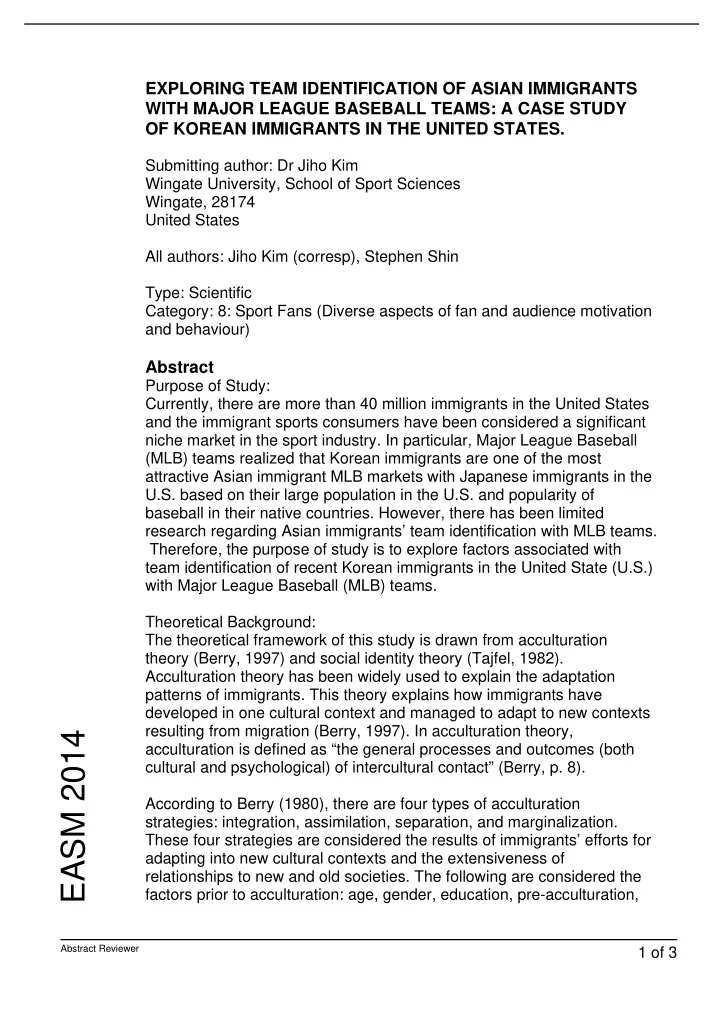

EXPLORING TEAM IDENTIFICATION OF ASIAN IMMIGRANTS WITH MAJOR LEAGUE BASEBALL TEAMS: A CASE STUDY OF KOREAN IMMIGRANTS IN THE UNITED STATES. Submitting author: Dr Jiho Kim Wingate University, School of Sport Sciences Wingate, 28174 United States All authors: Jiho Kim (corresp), Stephen Shin Type: Scientific Category: 8: Sport Fans (Diverse aspects of fan and audience motivation and behaviour) Abstract Purpose of Study:� Currently, there are more than 40 million immigrants in the United States and the immigrant sports consumers have been considered a significant niche market in the sport industry. In particular, Major League Baseball (MLB) teams realized that Korean immigrants are one of the most attractive Asian immigrant MLB markets with Japanese immigrants in the U.S. based on their large population in the U.S. and popularity of baseball in their native countries. However, there has been limited research regarding Asian immigrants’ team identification with MLB teams. Therefore, the purpose of study is to explore factors associated with team identification of recent Korean immigrants in the United State (U.S.) with Major League Baseball (MLB) teams. � � Theoretical Background: � The theoretical framework of this study is drawn from acculturation theory (Berry, 1997) and social identity theory (Tajfel, 1982). Acculturation theory has been widely used to explain the adaptation patterns of immigrants. This theory explains how immigrants have developed in one cultural context and managed to adapt to new contexts resulting from migration (Berry, 1997). In acculturation theory, EASM 2014 acculturation is defined as “the general processes and outcomes (both cultural and psychological) of intercultural contact” (Berry, p. 8).� � According to Berry (1980), there are four types of acculturation strategies: integration, assimilation, separation, and marginalization. These four strategies are considered the results of immigrants’ efforts for adapting into new cultural contexts and the extensiveness of relationships to new and old societies. The following are considered the factors prior to acculturation: age, gender, education, pre-acculturation, Abstract Reviewer 1 of 3
socioeconomic status, migration motivation and expectation, cultural distance between the host society and their origin culture, and immigrants’ personality. Factors with significant influence on acculturation include length of residence, acculturation strategies (attitudes and behaviors), social support from host society, and social attitudes (prejudice and discrimination from the host society members). � � Team identification research has been developed based on social identity theory and identity theory (Kwon, Trail, & James, 2007). In this study, social identity theory (Tajfel, 1982) is utilized as a theoretical framework for team identification. Social identity is defined as “the part of the individual’s self-concept which derives from their knowledge of their membership in a social group together with the value and emotional significance attached to that membership” (Tajfel, p. 2).� � Fink, Trail, and Anderson (2002) defined team identification as an extension of self-identity that occurs in a sports fan from his/her psychological connection to the team. According to Fink et al., nine concepts are highly correlated with team identification: (a) vicarious achievement, (b) acquisition of knowledge, (c) aesthetics, (d) social interaction, (e) drama, (f) escape, (g) family, (h) physical attractiveness of the participants, and (i) physical skill of the participants. � � Research Method� A qualitative design was employed to explore factors associated with recent Korean immigrants’ team identification with MLB teams. In this study, recent Korean immigrants refer to Koreans who came to the U.S. between 1980 and the present. The major questions for the in-depth semi-structured interview method consist of key perspectives which address significant aspects of their sport experiences and the meaning of having team identification with the Atlanta Braves and MLB teams with Korean players. The authors conducted thirteen in-depth interviews with both male and female Korean immigrants in the Atlanta area.� � Findings� The findings of the qualitative study show the following five factors elaborating and explaining essential perspectives in understanding team identification of Korean immigrants with MLB teams in the U.S.: (a) EASM 2014 adaptation patterns, (b) baseball involvement levels before migration to the U.S., (c) the presence of a Korean player, (d) team standing, and (e) satisfaction with immigrant life.� � Discussion & Implications� Regardless of adaptation patterns, the presence of Korean players in MLB games was the most appealing factor encouraging Korean immigrants to watch MLB games in the research. In previous studies, the vicarious achievement was the most significant motive for team identification (Fink et al., 2002), and it was described as the feeling Abstract Reviewer 2 of 3
Korean immigrants have when watching MLB games in which Korean players participate and the reason to watch them. The vicarious achievement can be interpreted to mean that the presence of Korean players in the U.S. was portrayed as a means to retain their ethnic identity though supporting Korean players. In addition, the presence of Korean players seems to be a means of providing important glue for the Korean immigrant community, the MLB teams, and the host society. This function would be one of the crucial roles of sports in the multicultural society and the ultimate goal of marketing that pursues mutually beneficial exchanges. In addition, the findings of this study showed that a holistic understanding of Korean immigrants’ lives in Atlanta is required for a better comprehension of their team identification with MLB teams. References Berry, J. B. (1997). Immigration, acculturation, and adaptation. Applied Psychology, 46(1), 5-68. � � Fink, J. S., Trail, G. T., & Anderson, D. F. (2002). A examination of team identification: which motivations are most salient to its existence. International Sports Journal, 6, 195-207.� � Kwon, H. H., Trail, G., & James, J. D. (2007). The Mediating Role of Perceived Value: Team Identification and Purchase Intention of Team- Licensed Apparel. Journal of Sport Management, 21(4).� � Tajfel, H. (1982). Social psychology of intergroup relations. Annual Review of Psychology, 33, 1-39. EASM 2014 Abstract Reviewer 3 of 3
Recommend
More recommend